Color of Scents Chromatic Stimuli Modulate Odor Responses in the
- 格式:pdf
- 大小:1.12 MB
- 文档页数:9
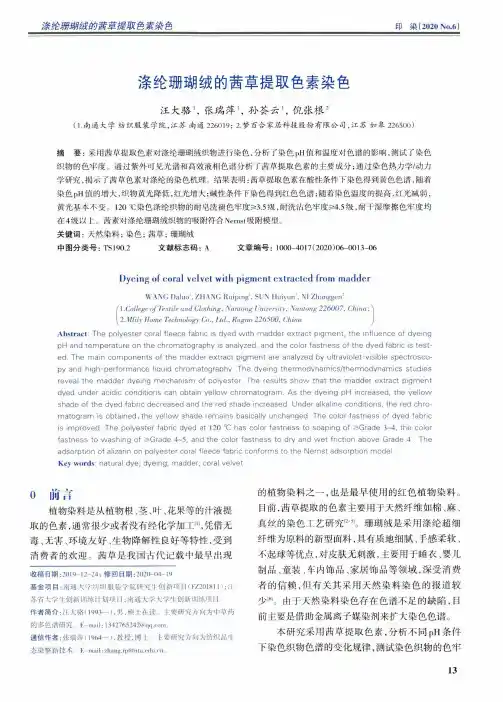
涤纶珊瑚绒的茜草提取色素染色印染(2020No.6)涤纶珊瑚绒的茜草提取色素染色汪大骆「,张瑞萍',孙荟云',倪张根2(1.南通大学纺织服装学院,江苏南通226019;2.梦百合家居科技股份有限公司,江苏如皋226500)摘要:采用茜草提取色素对涤纶珊瑚绒织物进行染色,分析了染色pH值和温度对色谱的影响,测试了染色织物的色牢度。
通过紫外可见光谱和高效液相色谱分析了茜草提取色素的主要成分;通过染色热力学/动力学研究,揭示了茜草色素对涤纶的染色机理。
结果表明:茜草提取色素在酸性条件下染色得到黄色色谱,随着染色pH值的增大,织物黄光降低,红光增大;碱性条件下染色得到红色色谱;随着染色温度的提高,红光减弱,黄光基本不变。
120t染色涤纶织物的耐皂洗褪色牢度M3.5级,耐洗沾色牢度刼.5级,耐干湿摩擦色牢度均在4级以上。
茜素对涤纶珊瑚绒织物的吸附符合Nernst吸附模型。
关键词:天然染料;染色;茜草;珊瑚绒中图分类号:TS190.2文献标志码:A文章编号:1000-4017(2020)06-0013-06Dyeing of coral velvet with pigment extracted from madderWANG Daluo1,ZHANG Ruiping1,SUN Huiyun1,NI Zhanggen21.College of Textile and Clothing,Nan l ong University,Nantong226007,China;2.Mlily Home Technology Co.,Ltd.,Rugao226500、ChinaAbstract:The polyester coral fleece fabric is dyed with madder extract pigme nt,the in f luence of dyeingpH and temperature on the chromatography is analyzed,and the color fastness of the dyed fabric is tested.The main comp o rients of the madder extract pigment are analyzed by ultraviolet-visible spectroscopy and high-performance liquid chromatography.The dyeing thermodynamics/thermodynamics studiesreveal the madder dyeing mechanism of polyester.The results show that the madder extract pigmentdyed under acidic conditions can obtai n yellow chromatogram.As the dyeing pH increased,the yellowshade of the dyed fabric decreased and the red shade in creased.Un der alkali ne conditions,the red chromatogram is obtained,the yellow shade remains basically unchanged.The color fastness of dyed fabricis improved.The polyester fabric dyed at120°C has color fastness to soaping of^Grade3〜4,the colorfastness to washing of^Grade4~5,and the color fastness to dry and wet friction above Grade4.Theadsorption of alizarin on polyester coral fleece fabric conforms to the Nernst adsorption model.Key words:natural dye;dyeing;madder;coral velvet0询言植物染料是从植物根、茎、叶、花果等的汁液提取的色素,通常很少或者没有经化学加工叫凭借无毒、无害、环境友好、生物降解性良好等特性,受到消费者的欢迎。

了不起的西普调花香调、果香调、木质调、海洋调……尽管香调没有统一的划分标准,但这些常见的香调顾名思义就能够理解,只有西普调,你很难从字里行间看出什么端倪。
西普,英文叫做Chypre,是1917年Coty公司调制的一款香水,这瓶被称为西普调“始祖”的香水,由佛手钳和苔藓混合而成,既散发花果的甜美,又不乏苔藓的刺激。
港台也会将这种由佛手钳与苔藓混合的香调译为“柑苔调”,但这并不能完全概括西普调的特质,因为西普调不仅仅只局限于柑橘与苔藓的混合,佛手钳与广藿香的混合也同样是经典的西普调,所以这种甜美清新又复杂神秘,立体丰满且极富层次的香调就自立门户,成了西普调。
西普调主要是五类材质的组合,第一类是柑橘类,我们常见的佛手钳、柠檬等都属于这一类。
第二类是花,像玫瑰、茉莉等等不胜枚举。
第三类是木质,广藿香就属于这一类。
第四类是橡苔,西普调里一般都含有苔藓。
第五类是麝香或者琥珀。
这五类材质中又有无数的细分,因此让西普调的组合充满了无数的可能性。
这也证是这种香调的魅力所在――多变而且让人捉摸不透,多一点花果香,就能展现女人的柔媚;多一点木质和橡苔,就立马散发出男人的阳刚。
花香西普、果香西普、木香西普、皮革西普……传统的西普调所包含的已经非常广泛,而现代西普因为多种独特新成分的发掘与加入,香调的划分更为具体细致。
随着技术的革新,五大材质的提炼方法和储存方法大为不同,原本潮湿厚重的西普调也变得更为明快轻盈,让现代西普更加平易近人。
近年来西普调爆发式的流行除了由于西普新香从故弄玄虚在往清新明快转变,更大程度上源于年轻人对个性的强调。
他们不再满足于单纯的花香或果香,西普调的特立独行就注定了它会脱颖而出,它的那一点点适当的难以驾驭,恰恰勾起了个性的年轻人去征服它的欲望。
从嗅觉上来说,西普调的这种个性拿捏得刚刚好,少一分便显得平庸而市场化,多一分往往容易招人反感。
西普调的多变性,使西普调显得感性而神秘。
因此在情感的投射上,也不再只停留在某一种香调的记忆里,而是多种香调的共同作用。
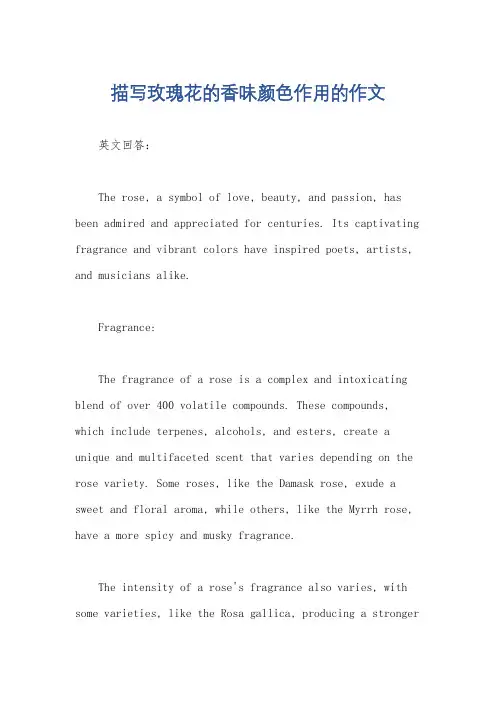
描写玫瑰花的香味颜色作用的作文英文回答:The rose, a symbol of love, beauty, and passion, has been admired and appreciated for centuries. Its captivating fragrance and vibrant colors have inspired poets, artists, and musicians alike.Fragrance:The fragrance of a rose is a complex and intoxicating blend of over 400 volatile compounds. These compounds, which include terpenes, alcohols, and esters, create a unique and multifaceted scent that varies depending on the rose variety. Some roses, like the Damask rose, exude a sweet and floral aroma, while others, like the Myrrh rose, have a more spicy and musky fragrance.The intensity of a rose's fragrance also varies, with some varieties, like the Rosa gallica, producing a strongerscent than others. The scent of a rose is strongest in the morning, when the flowers are fully open and the sun's warmth enhances the release of volatile compounds.Colors:Roses come in a wide range of colors, from classic hues like red, pink, and white to more exotic shades like purple, yellow, and orange. The color of a rose is determined bythe presence of specific pigments, such as anthocyanins (red), carotenoids (yellow), and flavonols (white).The red rose is perhaps the most iconic andrecognizable rose color. It is often associated with love, romance, and passion. Pink roses, on the other hand, symbolize grace, femininity, and admiration. White roses, known for their purity and innocence, are often used in weddings and other formal occasions.Effects:The rose has been used for centuries in bothtraditional and modern medicine. Its petals, leaves, andhips have been shown to possess a variety of therapeutic properties.Rose petals have been traditionally used as a soothing and astringent for the skin. They are rich in vitamins, antioxidants, and essential oils, which can help to hydrate, calm, and rejuvenate the skin. Rose petals are also commonly used in aromatherapy, where their calming and uplifting scent is believed to promote relaxation andreduce stress.Rose hips, the fruit of the rose plant, are anexcellent source of vitamin C, an antioxidant that can help to boost the immune system and protect against free radical damage. Rose hips are also a good source of fiber, pectin, and other compounds that can support digestive health and reduce inflammation.中文回答:玫瑰的香味:玫瑰花香浓郁醉人,是由400多种挥发性化合物共同作用的结果。
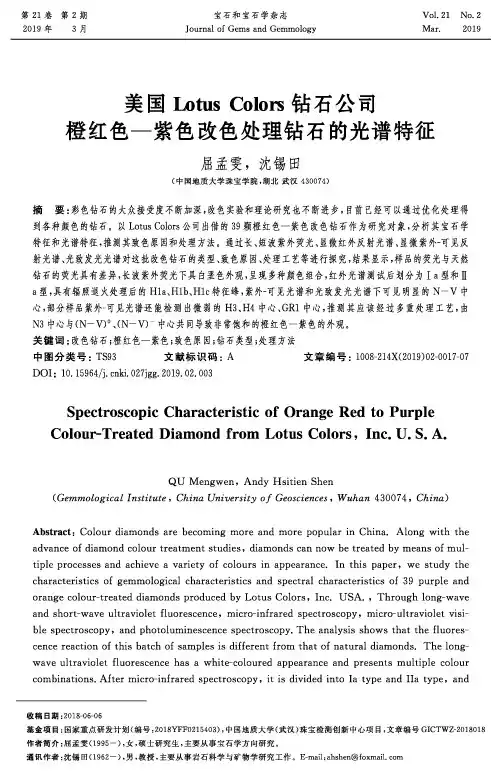
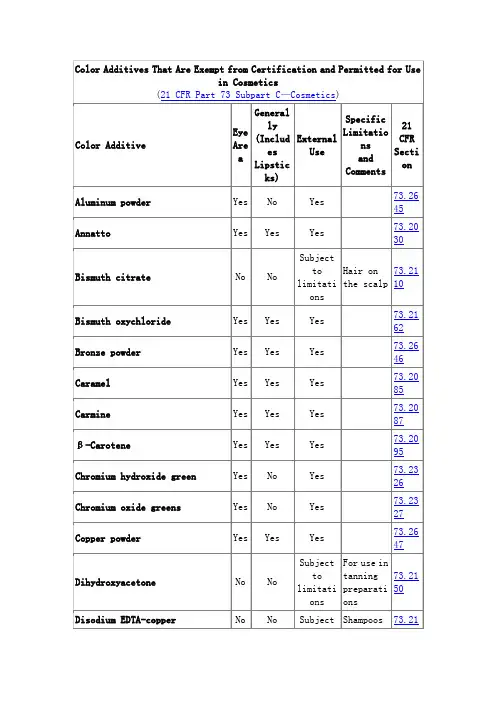
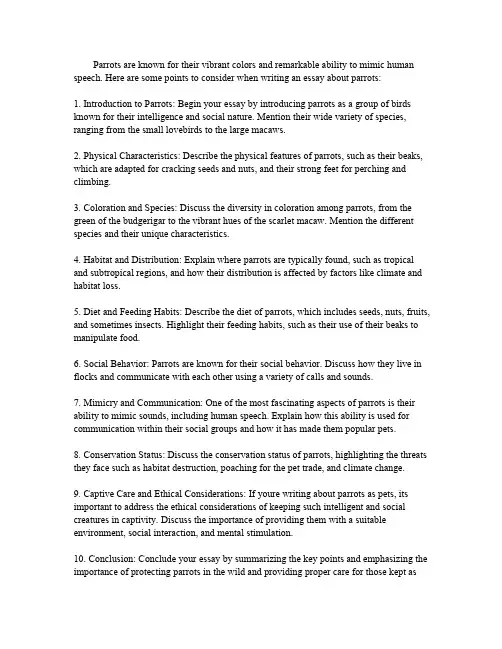
Parrots are known for their vibrant colors and remarkable ability to mimic human speech.Here are some points to consider when writing an essay about parrots:1.Introduction to Parrots:Begin your essay by introducing parrots as a group of birds known for their intelligence and social nature.Mention their wide variety of species, ranging from the small lovebirds to the large macaws.2.Physical Characteristics:Describe the physical features of parrots,such as their beaks, which are adapted for cracking seeds and nuts,and their strong feet for perching and climbing.3.Coloration and Species:Discuss the diversity in coloration among parrots,from the green of the budgerigar to the vibrant hues of the scarlet macaw.Mention the different species and their unique characteristics.4.Habitat and Distribution:Explain where parrots are typically found,such as tropical and subtropical regions,and how their distribution is affected by factors like climate and habitat loss.5.Diet and Feeding Habits:Describe the diet of parrots,which includes seeds,nuts,fruits, and sometimes insects.Highlight their feeding habits,such as their use of their beaks to manipulate food.6.Social Behavior:Parrots are known for their social behavior.Discuss how they live in flocks and communicate with each other using a variety of calls and sounds.7.Mimicry and Communication:One of the most fascinating aspects of parrots is their ability to mimic sounds,including human speech.Explain how this ability is used for communication within their social groups and how it has made them popular pets.8.Conservation Status:Discuss the conservation status of parrots,highlighting the threats they face such as habitat destruction,poaching for the pet trade,and climate change.9.Captive Care and Ethical Considerations:If youre writing about parrots as pets,its important to address the ethical considerations of keeping such intelligent and social creatures in captivity.Discuss the importance of providing them with a suitable environment,social interaction,and mental stimulation.10.Conclusion:Conclude your essay by summarizing the key points and emphasizing the importance of protecting parrots in the wild and providing proper care for those kept aspets.Remember to use descriptive language and,if possible,include anecdotes or personal experiences to make your essay more engaging.Additionally,ensure that your essay is wellstructured,with a clear introduction,body,and conclusion.。
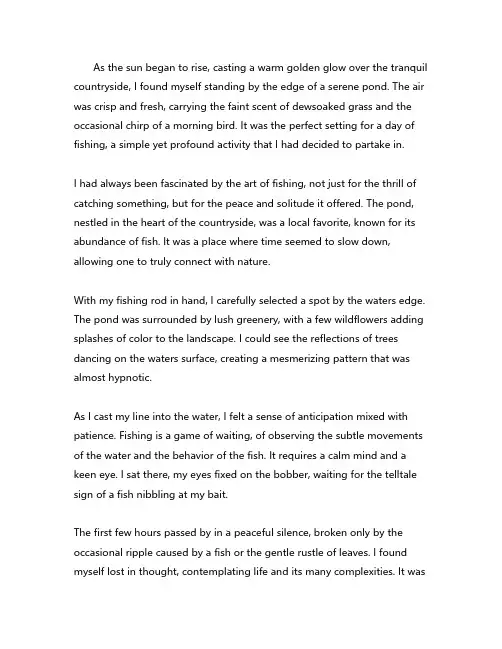
As the sun began to rise, casting a warm golden glow over the tranquil countryside, I found myself standing by the edge of a serene pond. The air was crisp and fresh, carrying the faint scent of dewsoaked grass and the occasional chirp of a morning bird. It was the perfect setting for a day of fishing, a simple yet profound activity that I had decided to partake in.I had always been fascinated by the art of fishing, not just for the thrill of catching something, but for the peace and solitude it offered. The pond, nestled in the heart of the countryside, was a local favorite, known for its abundance of fish. It was a place where time seemed to slow down, allowing one to truly connect with nature.With my fishing rod in hand, I carefully selected a spot by the waters edge. The pond was surrounded by lush greenery, with a few wildflowers adding splashes of color to the landscape. I could see the reflections of trees dancing on the waters surface, creating a mesmerizing pattern that was almost hypnotic.As I cast my line into the water, I felt a sense of anticipation mixed with patience. Fishing is a game of waiting, of observing the subtle movements of the water and the behavior of the fish. It requires a calm mind and a keen eye. I sat there, my eyes fixed on the bobber, waiting for the telltale sign of a fish nibbling at my bait.The first few hours passed by in a peaceful silence, broken only by the occasional ripple caused by a fish or the gentle rustle of leaves. I found myself lost in thought, contemplating life and its many complexities. It wasa moment of introspection, a chance to reflect on my own journey and the choices I had made.Suddenly, my bobber dipped beneath the water, jolting me back to the present. I felt a surge of excitement as I realized that a fish had taken the bait. With a swift pull of my rod, I began to reel in the fish, feeling the tension of the line as it fought against my pull. It was a dance of give and take, a test of strength and patience.After a few minutes of struggle, I finally managed to bring the fish to the surface. It was a beautiful specimen, its scales shimmering in the sunlight as it gasped for air. I felt a sense of accomplishment, not just for the catch, but for the experience itself.As I released the fish back into the water, watching it swim away, I was reminded of the cycle of life and the importance of respect for all creatures. Fishing was not just about catching fish it was about understanding and appreciating the delicate balance of nature.The day wore on, and I continued to cast my line, each time learning something new about the pond and its inhabitants. I observed the way the fish behaved, the patterns they followed, and the subtle changes in the waters flow. It was a lesson in observation and understanding, a reminder of the interconnectedness of all things.As the sun began to set, painting the sky in hues of orange and pink, I packed up my gear and prepared to leave. The day had been filled withquiet moments of reflection, exhilarating catches, and a deeper understanding of the world around me. It was a day of fishing, but it was also a day of learning and growth.Walking away from the pond, I felt a sense of gratitude for the experience and the lessons it had taught me. Fishing by the pond was more than just a leisurely activity it was a journey of selfdiscovery and a celebration of the beauty of nature. It was a day I would always cherish, a memory that would forever be etched in my heart.。
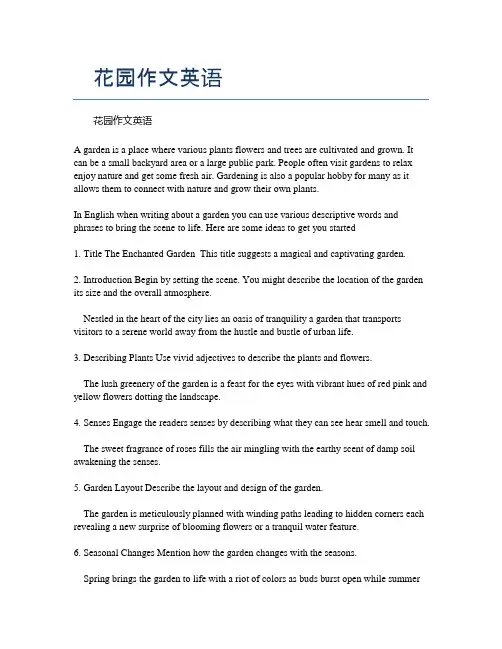
花园作文英语花园作文英语A garden is a place where various plants flowers and trees are cultivated and grown. It can be a small backyard area or a large public park. People often visit gardens to relax enjoy nature and get some fresh air. Gardening is also a popular hobby for many as it allows them to connect with nature and grow their own plants.In English when writing about a garden you can use various descriptive words and phrases to bring the scene to life. Here are some ideas to get you started1. Title The Enchanted Garden This title suggests a magical and captivating garden.2. Introduction Begin by setting the scene. You might describe the location of the garden its size and the overall atmosphere.Nestled in the heart of the city lies an oasis of tranquility a garden that transports visitors to a serene world away from the hustle and bustle of urban life.3. Describing Plants Use vivid adjectives to describe the plants and flowers.The lush greenery of the garden is a feast for the eyes with vibrant hues of red pink and yellow flowers dotting the landscape.4. Senses Engage the readers senses by describing what they can see hear smell and touch. The sweet fragrance of roses fills the air mingling with the earthy scent of damp soil awakening the senses.5. Garden Layout Describe the layout and design of the garden.The garden is meticulously planned with winding paths leading to hidden corners each revealing a new surprise of blooming flowers or a tranquil water feature.6. Seasonal Changes Mention how the garden changes with the seasons.Spring brings the garden to life with a riot of colors as buds burst open while summersees the garden in its full glory lush and vibrant.7. Wildlife Include the wildlife that inhabits the garden.Birds flit from branch to branch their melodic songs adding to the symphony of nature that plays out in this urban sanctuary.8. Human Interaction Describe how people interact with the garden.Visitors to the garden can often be seen strolling along the paths some lost in thought others engaged in lively conversation all enjoying the peaceful ambiance.9. Conclusion End with a reflection on the importance or impact of the garden.The garden serves as a reminder of the beauty and tranquility that can be found even in the most unexpected places a testament to the power of nature to heal and inspire. Remember to use a variety of sentence structures and vocabulary to make your essay engaging and descriptive. Happy writing。
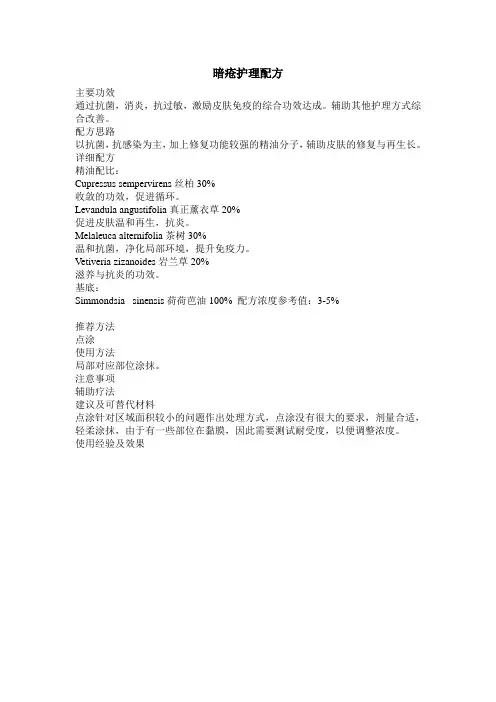
暗疮护理配方
主要功效
通过抗菌,消炎,抗过敏,激励皮肤免疫的综合功效达成。
辅助其他护理方式综合改善。
配方思路
以抗菌,抗感染为主,加上修复功能较强的精油分子,辅助皮肤的修复与再生长。
详细配方
精油配比:
Cupressus sempervirens丝柏30%
收敛的功效,促进循环。
Levandula angustifolia真正薰衣草20%
促进皮肤温和再生,抗炎。
Melaleuca alternifolia茶树30%
温和抗菌,净化局部环境,提升免疫力。
Vetiveria zizanoides岩兰草20%
滋养与抗炎的功效。
基底:
Simmondsia sinensis荷荷芭油100% 配方浓度参考值:3-5%
推荐方法
点涂
使用方法
局部对应部位涂抹。
注意事项
辅助疗法
建议及可替代材料
点涂针对区域面积较小的问题作出处理方式,点涂没有很大的要求,剂量合适,轻柔涂抹,由于有一些部位在黏膜,因此需要测试耐受度,以便调整浓度。
使用经验及效果。
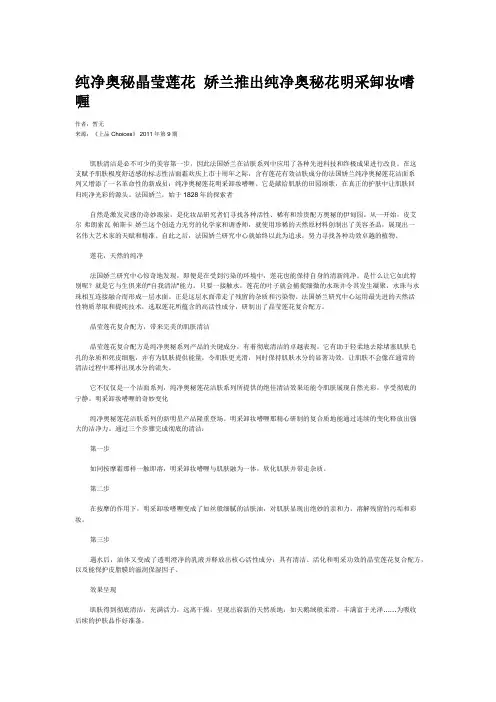
纯净奥秘晶莹莲花娇兰推出纯净奥秘花明采卸妆嗜喱作者:暂无来源:《上品Choices》 2011年第9期肌肤清洁是必不可少的美容第一步,因此法国娇兰在洁肤系列中应用了各种先进科技和终极成果进行改良。
在这支赋予肌肤极度舒适感的标志性洁面霜欢庆上市十周年之际,含有莲花有效洁肤成分的法国娇兰纯净奥秘莲花洁面系列又增添了一名革命性的新成员:纯净奥秘莲花明采卸妆嗜喱。
它是献给肌肤的田园颂歌,在真正的护肤中让肌肤回归纯净光彩的源头。
法国娇兰,始于1828年的探索者自然是激发灵感的奇妙源泉,是化妆品研究者们寻找各种活性、稀有和珍贵配方奥秘的伊甸园。
从一开始,皮艾尔·弗朗索瓦·帕斯卡·娇兰这个创造力无穷的化学家和调香师,就使用珍稀的天然原材料创制出了美容圣品,展现出一名伟大艺术家的天赋和精准。
自此之后,法国娇兰研究中心就始终以此为追求,努力寻找各种功效卓越的植物。
莲花,天然的纯净法国娇兰研究中心惊奇地发现,即便是在受到污染的环境中,莲花也能保持自身的清新纯净。
是什么让它如此特别呢?就是它与生俱来的“自我清洁”能力。
只要一接触水,莲花的叶子就会捕捉细微的水珠并令其发生凝聚,水珠与水珠相互连接融合而形成一层水面。
正是这层水面带走了残留的杂质和污染物。
法国娇兰研究中心运用最先进的天然活性物质萃取和提纯技术,选取莲花所蕴含的高活性成分,研制出了晶莹莲花复合配方。
晶莹莲花复合配方,带来完美的肌肤清洁晶莹莲花复合配方是纯净奥秘系列产品的关键成分,有着彻底清洁的卓越表现。
它有助于轻柔地去除堵塞肌肤毛孔的杂质和死皮细胞,并有为肌肤提供能量,令肌肤更光滑,同时保持肌肤水分的显著功效,让肌肤不会像在通常的清洁过程中那样出现水分的流失。
它不仅仅是一个洁面系列,纯净奥秘莲花洁肤系列所提供的绝佳清洁效果还能令肌肤展现自然光彩,享受彻底的宁静。
明采卸妆嗜喱的奇妙变化纯净奥秘莲花洁肤系列的新明星产品隆重登场。
明采卸妆嗜喱那精心研制的复合质地能通过连续的变化释放出强大的洁净力。
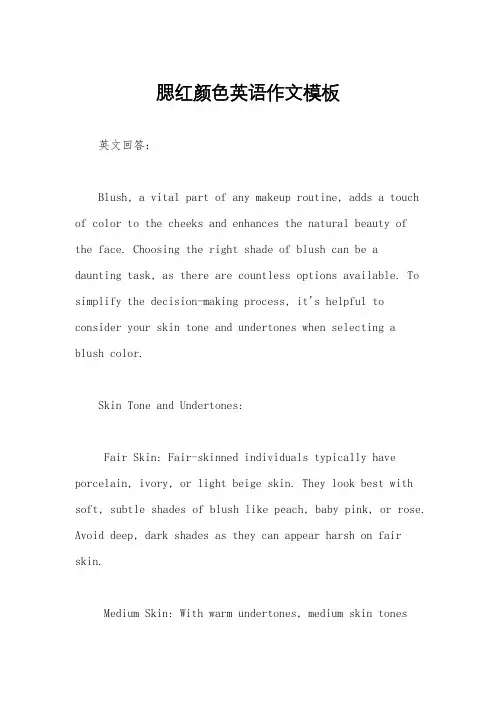
腮红颜色英语作文模板英文回答:Blush, a vital part of any makeup routine, adds a touch of color to the cheeks and enhances the natural beauty of the face. Choosing the right shade of blush can be a daunting task, as there are countless options available. To simplify the decision-making process, it's helpful to consider your skin tone and undertones when selecting a blush color.Skin Tone and Undertones:Fair Skin: Fair-skinned individuals typically have porcelain, ivory, or light beige skin. They look best with soft, subtle shades of blush like peach, baby pink, or rose. Avoid deep, dark shades as they can appear harsh on fair skin.Medium Skin: With warm undertones, medium skin toneslook radiant with warm shades like coral, apricot, or soft brown. Cool undertones complement medium skin tones with shades like dusty rose, mauve, or pink champagne.Olive Skin: Olive skin tones have a golden or greenish hue. Warm shades like terra cotta, golden peach, or brick red enhance olive skin's natural warmth. Cool tones, such as cranberry or plum, can also complement olive skin.Dark Skin: Dark skin tones come in a wide range, from rich chocolate to deep ebony. Deep berry shades like fuchsia, plum, or burgundy look stunning on dark skin. Warm shades like coral or burnt orange can also add a radiant glow.Specific Blush Color Shades:Peach: A classic and universally flattering shade, peach suits all skin tones, adding a touch of warmth and a healthy flush to the cheeks.Pink: Pink is a versatile shade that can createvarious looks. Soft pink adds a delicate touch of color, while deeper pink shades, like rose or fuchsia, make a bolder statement.Rose: Rose is a romantic shade that complements bothfair and medium skin tones. It adds a soft, rosy flush that mimics the natural color of flushed cheeks.Coral: Coral is a vibrant shade that adds a touch of warmth to the face. It looks particularly flattering on medium and olive skin tones.Terra Cotta: Terra cotta is a deep, earthy shade that complements olive and dark skin tones. It adds a warm, sun-kissed glow to the cheeks.Plum: Plum is a rich, berry shade that adds a touch of drama to the makeup look. It looks stunning on medium and dark skin tones, creating a sultry and sophisticated effect.Tips for Choosing the Right Blush:Consider your skin tone and undertones.Choose shades that complement your natural skin color.Try a variety of shades to find the perfect match.Apply blush lightly and blend well.Use a brush to apply blush for a more precise application.中文回答:腮红是任何化妆程序中至关重要的组成部分,它能为双颊增添一抹色彩,提升面部自然美。
小学下册英语第1单元真题(含答案)考试时间:100分钟(总分:100)B卷一、综合题(共计100题共100分)1. 选择题:What do you call a group of dogs?A. PackB. SchoolC. FlockD. Gaggle2. 听力题:A meteor shower occurs when Earth passes through ______.3. ssance artist Michelangelo is famous for painting the _____. 填空题:The Rena4. 填空题:The bark of a tree protects its ______ (内部).5. 听力题:The __________ is a critical area for studying the impacts of climate change.6. 填空题:The _____ (小羊) bleats softly when calling for its mother.7. 填空题:The _______ (Labor Movement) fought for workers’ rights and better conditions.8. 听力题:The concept of climate resilience emphasizes the capacity to adapt to ______ changes.9. 填空题:__________ (有机化合物) contain carbon and are found in living things.10. 选择题:Which insect makes honey?A. AntB. ButterflyC. BeeD. Fly答案:C11. 听力题:The weather is _____ today. (nice)12. 选择题:What is the main ingredient in sushi?A. ChickenB. FishC. RiceD. Vegetable答案:C13. 填空题:My dad is a _____ (工程师) involved in construction.14. 选择题:What is the name of the fairy tale character who lived in a shoe?A. Old Mother HubbardB. The Old Woman Who Lived in a ShoeC. GoldilocksD. Little Red Riding Hood答案:B15. 听力题:A _______ is a mixture where the components are not uniformly distributed.16. 填空题:My favorite season is ______ (秋季).17. 听力题:The chemical formula for barium hydroxide is _____.18. 选择题:What is the largest continent?A. AfricaB. AsiaC. EuropeD. Antarctica19. 填空题:The kite flies high in the _______ (风筝在_______中飞得很高).The __________ (历史的角色) shapes our understanding of identity.21. 填空题:I like to ______ (参加) motivational workshops.22. 选择题:What color is a traditional school bus?A. BlueB. YellowC. GreenD. Red23. 听力题:The bird is flying in the ________.24. 听力题:A reaction that absorbs energy is known as an ______ reaction.25. 选择题:What do we call the person who studies stars?A. BiologistB. AstronomerC. GeologistD. Chemist26. 听力题:Chemical compounds can be ________ or ionic.27. 填空题:The ________ was a major turning point in World War I.28. 听力题:The chemical formula for iron(III) chloride is _______.29. 填空题:He is a photographer, ______ (他是一名摄影师), capturing moments.30. 选择题:What is the capital city of Yemen?A. Sana'aB. AdenC. TaizD. Al HudaydahThe color of phenolphthalein changes in acidic and basic solutions, indicating ______.32. 听力题:A ______ is a type of fish that can glow.33. 选择题:Where does the sun rise?A. WestB. NorthC. SouthD. East答案:D34. 填空题:The __________ (历���的启示) guides our journey.35. 听力题:I want to _____ (become/learn) an artist.36. 填空题:My cousin has a __________兔子. (可爱的)37. 听力题:The __________ is a natural area with many trees.38. 听力题:The flowers are _____ in the sunshine. (smiling)39. 填空题:A _______ (小开心果) is a favorite snack for many animals.40. 听力题:The _____ (sun/moon) is bright.41. 听力题:My grandma loves to watch ____ (cooking shows).42. 听力题:A chemical reaction can involve the synthesis of _____.43. 听力题:The _____ of a solution can affect its reaction rate.44. 选择题:What do you call the process of growing crops?A. AgricultureB. HorticultureC. FarmingD. Cultivation答案:A45. 填空题:The _____ (生长) of a plant depends on sunlight and water.46. 选择题:What do you use to eat soup?A. ForkB. SpoonC. KnifeD. Plate答案: B47. 填空题:The _____ (猴子) is very curious and playful.48. 选择题:What is the name of the famous American holiday celebrated on the fourth Thursday in November?A. ChristmasB. ThanksgivingC. New Year's DayD. Independence Day答案:B49. 选择题:What is the name of the famous statue in Rio de Janeiro?A. Christ the RedeemerB. DavidC. LibertyD. Venus de Milo答案:A50. 听力题:The _____ (desk/table) is made of wood.51. 听力题:The puppy is __________ and cute.52. 选择题:What do we call a story that is not real?A. FictionB. Non-fictionC. BiographyD. History53. 填空题:My aunt loves to __________. (种花)54. 听力题:A ____ is a curious animal that explores new places.55. 读一读,想一想,选择恰当的单词,补全这首《家庭称呼礼貌歌)。
金缕梅时间:2021.03.01 创作:欧阳语金缕梅是一种生长在北美洲的落叶灌木是属于金缕梅科的植物。
金缕梅纯露是利用醇做溶剂,在低于25℃下通过超声波萃取金缕梅的叶子而得, 其主要成分有丹宁酸、类黄酮、精油,这些成分具有收敛、滋养、镇静的功效。
收敛抗炎、止痒、伤口愈合及镇静作用,能够使血管收缩成正常的年夜小,亦用于治疗痔疮与粉刺等,有很好的清洁净化和抗氧化功能!金缕梅多用途精华水以瑞士传奇集团magic care魔法护理系列为经典代表!收敛性化妆水、洗发精、面膜、须后水等产品。
鼠尾草:【化学成分】全草含β谷甾醇(βsitosterol),β谷甾醇葡萄糖甙(βsitosterol glucoside),熊果酸(ursolic acid),齐墩果酸(oleanolic acid),2α羟基熊果酸(2αhydroxyursolic acid),委陵菜酸(tormentic acid),咖啡酸(caffeic acid),马斯里酸(maslinic acid),乙基βD吡喃半乳糖甙(ethylβDgalactopyranoside)。
鼠尾草精油具有抗菌消炎的作用,能增进细胞再生,修护皮肤细胞组织,净化油腻的头皮,调节皮肤油脂排泄,减轻炎症和肿胀的肌肤问题,帮忙改良油性皮肤、粉刺、痤疮等肌肤问题。
洋甘菊:含有黄酮类环醚类及总挥发油等有不合水平的抗真菌作用,而黄酮类物质为主要抗炎成分。
【功效】对干性、敏感性皮肤极好;对治疗面疱、疱疹、湿疹、癣、微血管破裂有不错的功效;可以用来呵护脸部最敏感的眼部肌肤。
迭迭香:公认的最具备有抗氧化作用的植物迷迭香中的抗氧化成分主要为鼠尾草酸、鼠尾草酚、迷迭香酚、熊果酸、迷迭香酸等成分。
橙花:抗沮丧、抗菌、抗痉挛、杀菌、增进细胞活力、除臭、柔软皮肤、镇定。
美白、保湿、淡斑。
适合干性、敏感性及成熟型肌肤,对其它的皮肤问题也都有帮忙,特别是螺旋状的静疤痕、妊娠纹。
有助于防紫外线。
You might find this additional information useful...56 articles, 19 of which you can access free at:This article cites/cgi/content/full/93/6/3434#BIBL 1 other HighWire hosted article:This article has been cited by[PDF] [Full Text] [Abstract], July 1, 2006; 31 (6): 531-538. Chem Senses M Luisa Dematte, D. Sanabria and C. SpenceCross-Modal Associations Between Odors and Colors including high-resolution figures, can be found at:Updated information and services/cgi/content/full/93/6/3434 can be found at:Journal of Neurophysiology about Additional material and information /publications/jn This information is current as of April 17, 2008 . publishes original articles on the function of the nervous system. It is published 12 times a year Journal of Neurophysiology on April 17, 2008 Downloaded fromColor of Scents:Chromatic Stimuli Modulate Odor Responses in theHuman BrainRobert A.O ¨sterbauer,1Paul M.Matthews,1Mark Jenkinson,1Christian F.Beckmann,1Peter C.Hansen,2and Gemma A.Calvert 1,2,31Oxford Centre for Functional Magnetic Resonance Imaging of the Brain,John Radcliffe Hospital and 2University Laboratory of Physiology,University of Oxford,Oxford;and 3Department of Psychology,University of Bath,Bath,United KingdomSubmitted 27May 2004;accepted in final form 27January 2005O ¨sterbauer,Robert A.,Paul M.Matthews,Mark Jenkinson,Christian F.Beckmann,Peter C.Hansen,and Gemma A.Calvert.Color of scents:chromatic stimuli modulate odor responses in the human brain.J Neurophysiol 93:3434–3441,2005.First published February 2,2005;doi:10.1152/jn.00555.2004.Color has a profound effect on the perception of odors.For example,strawberry-flavored drinks smell more pleasant when colored red than green and descrip-tions of the “nose”of a wine are dramatically influenced by its ing functional magnetic resonance imaging,we demonstrate a neurophysiological correlate of these cross-modal visual influences on olfactory perception.Subjects were scanned while exposed either to odors or colors in isolation or to color-odor combinations that wererated on the basis of how well they were perceived to match.Activity in caudal regions of the orbitofrontal cortex and in the insular cortex increased progressively with the perceived congruency of the odor-color pairs.These findings demonstrate the neuronal correlates of olfactory response modulation by color cues in brain areas previously identified as encoding the hedonic value of smells.I N T R O D U C T I O N In everyday life,odors are often perceived together with visual cues.Both types of sensations interact to modulate the subjective experience of the stimuli from which they emanate.Behavioral studies demonstrated that the ability to correctly identify an odor relies heavily on visual inputs.For example,if subjects are presented with olfactory cues alone,only a few of the presented odors are identified correctly (Desor and Beauchamp 1974).There is a general lack of awareness of how difficult it can be to identify a substance by its odor alone because visual cues are usually present to facilitate identifica-tion.One visual feature with a particularly strong influence on odor perception is color.The color of a fruit,for example,provides an important visual cue about its ripeness and palat-ability.Several reports of strong associations between certain odors and colors (Gilbert et al.1996;Zellner and Kautz 1990)imply that such color-smell associations are most likely acquired and may be subject to variation between cultures.Nonetheless,some of these associations are particularly robust across sub-jects (e.g.,yellow—lemon).Several color-smell associations are so compelling that an odor percept can change with color,e.g.,subjects may perceive a cherry-flavored drink as orange-flavored if it is colored orange (DuBose et al.1980).Further-more,color not only facilitates odor identification but can alsoinfluence judgments of odor intensity and pleasantness.For example,both the perceived intensity and pleasantness of an appropriately colored solution (e.g.,red—strawberry)is judged as higher than that of an inappropriately colored (e.g.,green—strawberry)or a colorless solution even when the actual con-centration of odorant remains constant (Zellner et al.1991).More recently it has been found that tasteless red coloring added to a white wine induces a perceptual olfactory illusion that causes the wine to be described with olfactory terms typically used only for red wines (Morrot et al.2001).Despite the plethora of behavioral studies showing the in-fluence of color on various olfactory judgments,the neuro-physiological basis for these cross-modal interactions is still very poorly understood.In mammals,projections from the retina and olfactory bulb have been found to converge in thepiriform cortex,the olfactory tubercle,the cortical region of themedial amygdala,and the lateral hypothalamus (Cooper et al.1994).In primates,a prominent region for multisensory inte-gration of olfactory and visual signals is the orbitofrontalcortex (OFC),where afferent inputs from both primary olfac-tory cortex and higher-order visual areas converge (Ongur and Price 2000).Additionally,populations of bimodal neurons responsive to both visual and olfactory stimulation have been reported within the OFC of non-human primates (Rolls and Baylis 1994).Recently,a study using functional magnetic resonance imaging (fMRI)in humans reported that congruent picture-odor combinations (such as the image of a bus and the smell of diesel)enhance neural activity,in the OFC and hippocampus (Gottfried and Dolan 2003).Whether similar regions participate in the synthesis of odors and lower level visual features such as color remains to be explored.Although the precise neuronal mechanisms underlying the integration of visual and olfactory cues have not yet been studied in detail,some general principles characterizing cross-modal integration at the neuronal level have emerged from the study of other combinations of sensory modalities (Stein 1998).Specifically,when two or more sensory cues occur at the same time and in approximate spatial correspondence,the firing rate of a multisensory neuron to a stimulus in one modality can be measurably altered by the presence of a second stimulus in another modality.This is referred to as “multisen-sory integration.”Rarely,this cross-modal modulation of thecell’s output can exceed the sum of its response to eitherAddress for reprint requests and other correspondence:R.A.O ¨sterbauer,Oxford Centre for Functional Magnetic Resonance Imaging of the Brain,University of Oxford,John Radcliffe Hospital,Oxford OX39DU,UK (E-mail:robert@).The costs of publication of this article were defrayed in part by the payment of page charges.The article must therefore be hereby marked “advertisement ”in accordance with 18U.S.C.Section 1734solely to indicate this fact.J Neurophysiol 93:3434–3441,2005.First published February 2,2005;doi:10.1152/jn.00555.2004.on April 17, 2008 Downloaded frommodality in isolation (a phenomenon referred to as superaddi-tivity).Similar multisensory interactions have also been iden-tified in the context of human neuroimaging experiments in-volving the chemical senses (de Araujo et al.2003;Gottfried and Dolan 2003).In addition to the detection of cross-modalsuperadditive responses,systematic manipulation of the per-ceived congruency of two multisensory cues have also been shown to affect the height of the blood-oxygen-level-depen-dent (BOLD)response.In particular,increasingly better-matched cross-modal cues induce a corresponding enhance-ment of the hemodynamic response in areas thought to be involved in their combination.Parametric imaging designs such as these avoid some of the interpretation issues associated with superadditive interactions (see Calvert 2001and follow-ing text).We used fMRI to investigate whether similar multisensory mechanisms might underlie the interaction of visual color and olfactory cues in the generation of an olfactory percept in humans.Based on findings of previous human neuroimaging studies of olfaction by others (Anderson et al.2003;Gottfried and Dolan 2003;Gottfried et al.2002a;Rolls et al.2003;Zald and Pardo 2000;Zatorre et al.1992),we hypothesized that if olfactory responsive areas including the piriform cortex,amyg-dala,and OFC participate in the integration of odor-color cues,activity in these regions should increase systematically with increasingly better matched odor-color pair trials as rated on an individual and subjective basis.M E T H O D S Subjects Ten healthy right-handed volunteers participated in this study (6females and 4males;mean age:27yr,age range:22–35yr).Allparticipants gave written informed consent after having received the instructions for the study.One subject had to be discarded from the study because of excessive motion during scanning.Data analysis at the group level thus includes nine subjects.The study was approved by the Central Oxford Research Ethics Committee (C99.179).Stimuli and task In a behavioral experiment prior to scanning,40subjects were asked to match 1of 17different odors (Quest Intl.)to 1of 10different isoluminant colors presented on a computer screen and to rate the intensity,familiarity,and pleasantness of each odor and then attempt to identify it.Thirteen of the 17odors were significantly often matched to one particular color (P Ͻ0.01).Of these,the four color-odor pairs showing the most consistent match across subjects were used in the fMRI study.These congruent pairings were yellow—lemon,strawberry—red,spearmint—turquoise,and caramel—brown and were presented during scanning as well as the variably less congruent pairings of each odor with the remaining three colors.The four smells were highly matched for pleasantness,intensity,and familiarity (Table 1).During scanning,subjects were presented for 6s with a visual stimulus (yellow,red,turquoise,or brown),an olfactory stimulus (lemon,strawberry,spearmint,or caramel)or a bimodal visual-olfactory stimulus.The order of each of the three conditions was randomized.Each presentation was followed by a rest period of 30s to avoid habituation to the odor stimuli.For the unimodal conditions,each of the four olfactory and color stimuli was presented three times.For the bimodal conditions,each odor was presented three times with a congruent color (i.e.,lemon—yellow)and once with each of the remaining three colors.Overall,12visual,12olfactory,and 24bimodal stimuli were presented over a period of 28min 48s.Before scanning,subjects were informed that odors may occur in isolation or in the presence of a simultaneously presented color.In addition,color patches could also occur in the absence of an odor.They were also told that the order of these events would be random so they should maintain their attention to both channels equally through-out the experiment.Subjects were also instructed that on the bimodal conditions only,they were to rate each color-smell combination with respect to “goodness of fit between color and smell”on a rating scale ranging from 1ϭvery good to 4ϭvery bad using a four-button response box.Rating responses were cued by the word “rate”pre-sented 15s after the end of each bimodal presentation.To control for the motor response to the visual cue between the bi-and unimodalconditions,the same visual cue also appeared 15s after each unimodalpresentation,and subjects were instructed to press any of the fourbuttons.The advantage of a parametric design that requires a cross-modal congruency judgment is that it allows multisensory color-odorintegration sites to be identified in the covariance analysis betweenbimodal trials and rating judgments.However,as the same judgmentcannot be made in the unimodal conditions (for example,it is not possible for humans to rate the congruency between 2simultaneously presented odors),contrasts between the bi-and unimodal conditions may be confounded by differences in the task requirements.Therefore superadditive effects [OV –(O ϩV)]must be interpreted cautiously.Full-screen color images were generated using a video projectorlocated outside the scanner room and projected onto a translucentscreen placed directly outside the magnet bore.Subjects wore prismglasses so that they could see the screen while lying in the scanner.Olfactory stimuli were delivered using a custom-built,computer-controlled olfactometer.This was identical in design to that used by Rolls and colleagues (for a detailed description,see Rolls et al.2003)so that switching between odorized and odorless air was free of any auditory,tactile,or thermal cues that could have alerted the subjects to the onset of odor delivery.Subjects were asked to breathe normally through their nose for the duration of the scan while an air stream of either odorized or odorless air was delivered at a flow rate of 6l/s through a Teflon tube placed directly under the subject’s nose.They were also informed that although during most presentations,the visual stimulus would be accompanied by an odor,they should refrain from sniffing at the onset of a color cue and continue to breathe normally.This instruction was included to avoid sniff-related activation of olfactory areas (Sobel et al.1998)in the color-alone condition.Furthermore,in the absence of a color cue in the odor-alone condition,sniffing only at the onset of trials containing a color stimulus could have resulted in a potential confound of the comparison between bimodal color-odor and odor-alone conditions.Instead,during the scan,subjects were asked to detect the onset and offset of odors and to signal these events by making an appropriate ON -OFF button re-sponse.This method resulted in a slight jitter in the onset and duration of the odor trials that was taken into account for data analysis.TABLE 1.Ratings of pleasantness,intensity and familiarity for the 4odorsLemon Strawberry Spearmint Caramel Pleasantness 5.6Ϯ1.2 4.9Ϯ1.5 5.3Ϯ1.6 3.3Ϯ1.6*Intensity 5.4Ϯ1.0 5.0Ϯ1.2 5.1Ϯ1.0 4.9Ϯ1.2Familiarity 6.2Ϯ1.1 5.3Ϯ1.7† 6.0Ϯ1.3 4.5Ϯ1.7‡Values are means ϮSD of the behavioral ratings on a 7-point scale for 40subjects.*,significantly (P Ͻ0.05)different from the remaining three odors.†,significantly (P Ͻ0.05)different from lemon.‡,significantly (P Ͻ0.05)different from lemon and spearmint.3435MULTISENSORY INTEGRATION OF COLOR AND SMELL on April 17, 2008 Downloaded fromData acquisition and analysis Both functional and structural MRI images were acquired on a Siemens/Varian 3T system fitted with a birdcage head coil.For the functional data series,a total of 581T2*-weighted echo-planar imag-ing (EPI)volumes were taken over a time period of 28min 48s.Each volume consisted of 25continuous oblique coronal slices that were tilted ϳ20°toward the axial plane with an in-plane resolution of 3ϫ2.5mm and a thickness of 3mm,covering the anterior half of the brain dorsally reaching a y coordinate of ϩ4of the Montreal Neuro-logical Institute (MNI)standard space and a ventral coordinate of y ϭϪ12.This allowed coverage of all primary and secondary olfactory areas in OFC and the temporal lobes.Other imaging parameters were:TR ϭ3s,64ϫ64matrix,FOV 192ϫ160mm,TE ϭ25ms,flip angle 90°.To minimize susceptibility artifacts in orbitofrontal brainregions,slices were acquired in the oblique coronal orientation (Deichmann et al.2003)with a short echo time of 25ms and a smallin-plane voxel size.Additionally an automated frontal-weighted local shimming method was used (Wilson et al.2002).This imaging protocol is optimized for fMRI studies of OFC function and has been extensively used by other groups on the same scanner (Rolls et al.2003).For registration into standard space,a whole brain T2*-weighted EPI volume (54slices,TR ϭ7s)and a high-resolution,whole brain T1-weighted morphological scan (1.5mm slice thickness,1.5ϫ1.5mm in-plane resolution)was acquired after the experimental para-digm.Statistical image analysis was carried out using the FMRIB Soft-ware Library (/fsl).The initial strategy for ana-lyzing the bimodal condition was to first test for a linear correlation between the BOLD response and ratings of the congruency between smells and colors and then to assess superadditivity (i.e.,where theactivation to bimodal stimuli exceeds the sum of both unimodalstimuli).Prior to data analysis,the first 3volumes were deleted.Analysis was carried out using the FMRIB expert-analysis tool (FEAT).The following preprocessing was applied:motion correction using MCFLIRT (Jenkinson et al.2002);spatial smoothing using aGaussian kernel of FWHM 5mm;mean-based intensity normalization of all volumes by the same factor;nonlinear high-pass temporal filtering (Gaussian-weighted LSF straight line fitting,sigma ϭ36.0s).Each of the three event types (visual,olfactory,and bimodal)was modeled as a separate explanatory variable.A fourth explanatory variable with the same time course as the bimodal one was used to model the linear correlation between the BOLD response and the behavioral rating for the degree of matching.This variable was orthogonalized with respect to the bimodal one.Statistical analysis was carried out using FMRIB’s improved linear model (FILM)with local autocorrelation correction (Woolrich et al.2001).For group analysis,the individual results were registered both to high-resolution anatomical MR images and to the MNI 152standard image.Registration to high-resolution and standard images was car-ried out using FMRIB’s linear image registration tool (FLIRT)(Jen-kinson et al.2002).Mixed-effects (often referred to as “random-effects”)group analysis was carried out using FMRIB’s local analysis of mixed effects (FLAME)software (Beckmann et al.2003)with a cluster threshold of Z Ͼ2.0and a cluster significance threshold ofP ϭ0.05(corrected for multiple comparisons)(Forman et al.1995;Friston et al.1994;Worsley et al.1992).This threshold was specif-ically chosen on the basis of pilot experiments that showed robust activation in olfactory areas in both temporal and orbitofrontal corti-ces using these parameters.R E S U L T S Behavioral Analysis of the behavioral responses obtained during the fMRI experiment showed that for three odors (lemon,spear-mint,and caramel),the color-smell combinations rated as most congruent in our preliminary experiment were indeed rated as significantly (Student’s t -test P Ͻ0.05)better matching than combinations of the same odor with any of the other three colors (Table 2).Although the strawberry odor showed a trend toward higher perceived congruence with red than the other three colors,the only statistically significant difference oc-curred between red and the turquoise.Note,however,that for the fMRI data analysis,each individual congruency rating for a bimodal trial was used to model the BOLD response (i.e.,if a subject perceived the combination spearmint-brown as a very good match,then this was accounted for in the analysis model).Unimodal stimulationPresentation of odors alone produced bilateral activation in the piriform cortex/amygdaloid region (x,y,z ϭ14,Ϫ6,Ϫ30;Z score ϭ3.81and x,y,z ϭϪ22,Ϫ2,Ϫ18;Z score ϭ3.29)and theputamen (x,y,z ϭ14,Ϫ4,Ϫ10;Z score ϭ3.83and x,y,z ϭϪ6,2,Ϫ8;Z score ϭ4.22;Fig.1A ).Lateralized activation was observed in the right orbitofrontal gyrus (x,y,z ϭ24/32/-24;Zscore ϭ4.38)and in the left insular cortex (x,y,z ϭϪ44,2,Ϫ14;Z score ϭ3.49).Both piriform and orbitofrontal areas are con-sidered to be primary and secondary olfactory cortices in primates (Tanabe et al.1975)and have been shown to activate in response to odorants in human neuroimaging studies (Zald and Pardo 2000).There was no significant activation of these regions when colors were presented alone.Bimodal modulation and congruencyUsing the ratings of relative color-odor congruency as a parametrically varying explanatory variable for brain activa-tion changes,a network of brain areas exhibiting increasingactivity with progressively higher perceived congruency was identified (Fig.2).This network was entirely left lateralized and was mainly localized within the caudal orbitofrontal cortex around the olfactory sulcus (x,y,z ϭϪ16,32,Ϫ4;Z score ϭ3.88),inferior frontal gyrus pars orbitalis (x,y,z ϭϪ20,22,Ϫ16;Z score ϭ2.92)and gyrus rectus (x,y,z ϭϪ8,16,Ϫ24;Z score ϭ3.34).Other brain regions exhibiting the same color-odor modulations were found in the anterior insular cortex (x,y,z ϭϪ32,22,Ϫ8;Z score ϭ2.75),the frontal operculum (x,y,z ϭϪ54,24,4;Z score ϭ2.68),and thetemporal pole (x,y,z ϭϪ56,18,Ϫ8;Z score ϭ3.03).SuperadditivityTo assess whether indices of multisensory interactions sim-ilar to those previously reported in electrophysiological (Stein TABLE 2.Ratings of congruence for color-odor pairings Lemon Strawberry Spearmint Caramel Yellow 1.1Ϯ0.3* 2.6Ϯ1.0 3.8Ϯ0.4 3.2Ϯ0.8Red 3.2Ϯ0.7 2.0Ϯ1.0† 3.2Ϯ1.1 4.0Ϯ0.0Turquoise 3.1Ϯ0.6 3.0Ϯ0.9 1.6Ϯ1.1* 3.1Ϯ1.1Brown 2.4Ϯ1.1 2.3Ϯ0.7 2.3Ϯ0.5 1.9Ϯ0.9*Values are means ϮSD of the behavioral ratings of all color-odor combinations presented during the experiment on a 4-point scale (1ϭvery good match and 4ϭvery bad match)for all 9subjects.*,significantly (P Ͻ0.05)different from theremaining three colors.†,significantly (P Ͻ0.05)different from turquoise.3436O ¨STERBAUER,MATTHEWS,JENKINSON,BECKMANN,HANSEN,AND CALVERTon April 17, 2008 Downloaded from1998)and neuroimaging experiments (Calvert 2001)could be identified in the current imaging experiment,we compared the BOLD response to odor-color pairings to the activation ofodors and colors alone [bimodal Ϫ(odors ϩcolors)].This included the behavioral ratings in the overall model,so that theheight of the BOLD response to a “very good fit”was modeled as larger than the response to a “very bad fit.”Several regions displayed effects of superadditivity (Fig.1,C and D ):the medial wall of the superior frontal gyrus (x,y,z ϭϪ8,48,26;Z score ϭ4.48),the superior transverse frontopolar gyrus extending caudally into the anterior cingulate cortex (x,y,z ϭ4,48,8;Z score ϭ3.96and x,y,z ϭϪ10,48,4;Z score ϭ3.83)and the OFC along the gyrus rectus (x,y,z ϭ4,28,Ϫ19;Z score ϭ3.16and x,y,z ϭϪ4,35,Ϫ18;Z score ϭ3.07).Neural suppression and incongruency Incongruency in stimulus properties has been shown to suppress neuronal activity for audiovisual stimulus combina-tions (Calvert 2001)and congruent olfactory-taste stimuli have been reported to cause neural suppression (Small et al.1997).To investigate whether similar effects are observable for ol-factory-visual stimuli,we tested the linear correlation of the BOLD response with incongruency (i.e.,brain areas that re-spond increasingly stronger the more incongruent the stimulus combinations are)and did not find an effect.Similarly,incon-gruent visual-olfactory stimuli did not significantly decrease the BOLD response below the levels observed to olfactory stimuli alone (Fig.3).D I S C U S S I O NThe aim of this study was to probe the neurophysiological basis of visual influences on odor perception using fMRI.The presentation of odors in the absence of visual cues was first shown to stimulate the piriform/amygdaloid region,the right OFC and left insular cortex—consistent with previous olfac-tory neuroimaging experiments (Anderson et al.2003;Gott-fried et al.2002a;Poellinger et al.2001;Rolls et al.2003;Zaldand Pardo 2000).These areas are understood to correspond to human primary olfactory and associative olfactory cortices,respectively.A subset of these olfactory-responsive areas wasalso found to be sensitive to the perceived congruency ofbimodal odor-color trials.Specifically,activation in the orbito-frontal and insular cortices increased in strength with increas-ingly higher ratings of the perceived congruency between specific odors and color patches.These findings are consistent with the hypothesis that color modifies the perception of odors at a relatively late stage of olfactory processing in heteromodal regions of the OFC and a region of the insular cortex previ-ously implicated in flavor processing (de Araujo et al.2003).The detection of cross-modal modulatory effects in a net-work of areas including the OFC and insular cortex suggests that color may influence different aspects of olfactory process-ing.The OFC receives converging projections frommultipleFIG .1.Group response to odor stimulation alone and brainregions displaying effects of superadditivity [bimodal Ϫ(vi-sion ϩsmell)].Olfactory stimulation (A )evoked neural re-sponses bilaterally in the piriform cortex/amygdala (white),theventral striatum (blue),and the left insular cortex (red)as wellas in the right orbitofrontal cortex (B ).Superadditive responseswere observed in medial orbitofrontal cortex (C,white)and thesuperior frontal gyrus (blue)and the anterior cingulate (D,white).Slice y coordinates are in the Montreal NeurologicalInstitute (MNI)standard space and the right side of the brain isshown on the right side of the pictures.3437MULTISENSORY INTEGRATION OF COLOR AND SMELL on April 17, 2008 Downloaded fromsensory modalities,including the primary olfactory cortex and the ventral visual pathway (Ongur and Price 2000;Rolls andBaylis 1994),making it a plausible initial site of information exchange between the visual and olfactory systems.Electro-physiological studies in non-human primates and imaging experiments in humans have implicated the OFC in stimulus-reinforcement associative learning using olfactory and visual stimuli (Gottfried et al.2002b,2003).For example,responses in the OFC to olfactory,gustatory,or visual cues previously associated with certain foods,are diminished when subjects are fed to satiety (Rolls 2001),and activity in this region has beenshown to increase according to the perceived pleasantness ofolfactory stimuli (Anderson et al.2003).Together,these datacontribute to the mounting evidence that it is specifically therewarding properties of the sensory cues that are represented inthe OFC.The systematic BOLD increase observed in thecurrent study is therefore likely to reflect the physiologicalmechanism underlying the behavioral phenomenon wherebythe more appropriate the color-odor combination,the greater isthe perceived pleasantness of the odor (Zellner et al.1991).In addition to changing the hedonic value of odors,colorshave also been shown to influence the perception of flavor(Rolls et al.1982).Visuo-olfactory modulated responses in thecurrent experiment were also detected in the left anteriorinsular cortex and the adjacent frontal operculum.These re-gions have previously been identified as areas of primary tastecortex in monkeys (Plata-Salaman et al.1995;Yaxley et al.1990)and are consistently activated during human imaging studies of taste (Frey and Petrides 1999;O’Doherty et al.2001;Small et al.1999,2003).However,the agranular insular,located at the caudal border of the OFC,is also responsive to olfactory inputs (Weismann et al.2001),and neuroimaging studies of olfaction have reported activation in this region (Cerf-Ducastel and Murphy 2001;de Araujo et al.2003;FIG .2.Brain regions showing odor-colormodulation.A :the group activation map showsthe main cluster of activation (red crosshairs)inthe caudal region of the left orbitofrontal cortex(OFC;x,y,z ϭϪ8,16,Ϫ24;Z score ϭ3.34)inall 3slice orientations.Here,the blood-oxygen-level-dependent (BOLD)signal increased withgreater perceived odor-color congruency.All ac-tivated voxels were rendered onto the standardMNI brain and the right side of the brain isshown on the right side of the pictures.B :thepanel shows the parameter estimates for smellalone and the 4different degrees of congruencyof the color-odor pairs (ranging from 1ϭverygood to 4ϭvery bad)averaged across all 9subjects.Black lines indicate the SE and aster-isks significance levels of t -test (**ϭP Ͻ0.01,*ϭP Ͻ0.05,and NS ϭnotsignificant).FIG .3.Time course of activation.The chart shows the group (n ϭ9)averaged time course of the percentage BOLD signal changes for both matching (rating of 1)and mismatching (rating of 4)odor-color trials as well as the odor alone trials in the peak voxel within the left OFC (x,y,z ϭϪ8,16,Ϫ24).Stimulation started at time 0and lasted for 6s.As can be seen,congruent odor-color pairs elicited a significantly greater BOLD response than that observed to either incongruent pairs (t ϭ3.05,df ϭ8,P Ͻ0.01)or odors in isolation (t ϭ3.26,df ϭ8,P Ͻ0.01).Note,differences in the time to peak across conditions are most likely to reflect corresponding differences in BOLD amplitude (Miezin et al.2000).3438O ¨STERBAUER,MATTHEWS,JENKINSON,BECKMANN,HANSEN,AND CALVERTon April 17, 2008 Downloaded from。